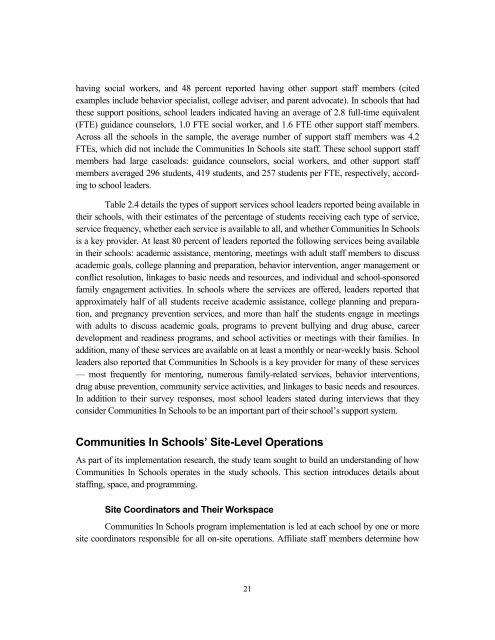NNFGV
NNFGV
NNFGV
You also want an ePaper? Increase the reach of your titles
YUMPU automatically turns print PDFs into web optimized ePapers that Google loves.
having social workers, and 48 percent reported having other support staff members (cited<br />
examples include behavior specialist, college adviser, and parent advocate). In schools that had<br />
these support positions, school leaders indicated having an average of 2.8 full-time equivalent<br />
(FTE) guidance counselors, 1.0 FTE social worker, and 1.6 FTE other support staff members.<br />
Across all the schools in the sample, the average number of support staff members was 4.2<br />
FTEs, which did not include the Communities In Schools site staff. These school support staff<br />
members had large caseloads: guidance counselors, social workers, and other support staff<br />
members averaged 296 students, 419 students, and 257 students per FTE, respectively, according<br />
to school leaders.<br />
Table 2.4 details the types of support services school leaders reported being available in<br />
their schools, with their estimates of the percentage of students receiving each type of service,<br />
service frequency, whether each service is available to all, and whether Communities In Schools<br />
is a key provider. At least 80 percent of leaders reported the following services being available<br />
in their schools: academic assistance, mentoring, meetings with adult staff members to discuss<br />
academic goals, college planning and preparation, behavior intervention, anger management or<br />
conflict resolution, linkages to basic needs and resources, and individual and school-sponsored<br />
family engagement activities. In schools where the services are offered, leaders reported that<br />
approximately half of all students receive academic assistance, college planning and preparation,<br />
and pregnancy prevention services, and more than half the students engage in meetings<br />
with adults to discuss academic goals, programs to prevent bullying and drug abuse, career<br />
development and readiness programs, and school activities or meetings with their families. In<br />
addition, many of these services are available on at least a monthly or near-weekly basis. School<br />
leaders also reported that Communities In Schools is a key provider for many of these services<br />
— most frequently for mentoring, numerous family-related services, behavior interventions,<br />
drug abuse prevention, community service activities, and linkages to basic needs and resources.<br />
In addition to their survey responses, most school leaders stated during interviews that they<br />
consider Communities In Schools to be an important part of their school’s support system.<br />
Communities In Schools’ Site-Level Operations<br />
As part of its implementation research, the study team sought to build an understanding of how<br />
Communities In Schools operates in the study schools. This section introduces details about<br />
staffing, space, and programming.<br />
Site Coordinators and Their Workspace<br />
Communities In Schools program implementation is led at each school by one or more<br />
site coordinators responsible for all on-site operations. Affiliate staff members determine how<br />
21


